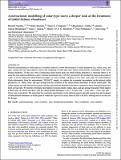Por favor, use este identificador para citar o enlazar a este item:
http://hdl.handle.net/10261/229148COMPARTIR / EXPORTAR:
 SHARE SHARE
 CORE
BASE CORE
BASE
|
|
| Visualizar otros formatos: MARC | Dublin Core | RDF | ORE | MODS | METS | DIDL | DATACITE | |

| Título: | Asteroseismic modelling of solar-type stars: A deeper look at the treatment of initial helium abundance |
Autor: | Nsamba, Benard; Moedas, Nuno; Campante, Tiago L.; Cunha, Margarida S.; García Hernández, Antonio CSIC ORCID; Suárez Yanes, Juan Carlos; Monteiro, Mario J.P.F.G.; Fernandes, João; Jiang, Chen; Akinsanmi, Babatunde | Palabras clave: | Asteroseismology Stars: evolution Stars: fundamental parameters Stars: oscillations Stars: statistics |
Fecha de publicación: | 2021 | Editor: | Oxford University Press | Citación: | Monthly Notices of the Royal Astronomical Society 500: 54-65 (2021) | Resumen: | Detailed understanding of stellar physics is essential towards a robust determination of stellar properties (e.g. radius, mass, and age). Among the vital input physics used in the modelling of solar-type stars which remain poorly constrained, is the initial helium abundance. To this end, when constructing stellar model grids, the initial helium abundance is estimated either (i) by using the semi-empirical helium-to-heavy element enrichment ratio, (ΔY/ΔZ), anchored to the standard big bang nucleosynthesis value, or (ii) by setting the initial helium abundance as a free variable. Adopting 35 low-mass, solar-type stars with multiyear Kepler photometry from the asteroseismic ‘LEGACY’ sample, we explore the systematic uncertainties on the inferred stellar parameters (i.e. radius, mass, and age) arising from the treatment of the initial helium abundance in stellar model grids. The stellar masses and radii derived from grids with free initial helium abundance are lower compared to those from grids based on a fixed ΔY/ΔZ ratio. We find the systematic uncertainties on mean density, radius, mass, and age arising from grids which employ a fixed value of ΔY/ΔZ and those with free initial helium abundance to be ∼ 0.9 per cent, ∼ 2 per cent, ∼ 5 per cent, and ∼ 29 per cent, respectively. We report that the systematic uncertainties on the inferred masses and radii arising from the treatment of initial helium abundance in stellar grids lie within the expected accuracy limits of ESA’s PLATO, although this is not the case for the age. © 2020 The Author(s). | Versión del editor: | http://dx.doi.org/10.1093/mnras/staa3228 | URI: | http://hdl.handle.net/10261/229148 | DOI: | 10.1093/mnras/staa3228 | Identificadores: | doi: 10.1093/mnras/staa3228 e-issn: 1365-2966 |
| Aparece en las colecciones: | (IAA) Artículos |
Ficheros en este ítem:
| Fichero | Descripción | Tamaño | Formato | |
|---|---|---|---|---|
| IAA_2021MNRAS.500...54N.pdf | 3,64 MB | Adobe PDF |  Visualizar/Abrir |
CORE Recommender
SCOPUSTM
Citations
12
checked on 13-abr-2024
WEB OF SCIENCETM
Citations
11
checked on 26-feb-2024
Page view(s)
104
checked on 18-abr-2024
Download(s)
136
checked on 18-abr-2024
Google ScholarTM
Check
Altmetric
Altmetric
NOTA: Los ítems de Digital.CSIC están protegidos por copyright, con todos los derechos reservados, a menos que se indique lo contrario.
